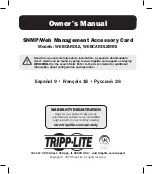
Chapter 1: Configuration
Configuring IP and Ethernet interfaces
Page
1-29
NAT, DHCP Server, DHCP Client and DMZ
Applicable products
PMP:
SM
The system provides NAT (Network Address Translation) for SMs in the following combinations of NAT
and DHCP (Dynamic Host Configuration Protocol):
•
NAT Disabled
•
NAT with DHCP Client (DHCP selected as the Connection Type of the WAN interface) and DHCP
Server
•
NAT with DHCP Client(DHCP selected as the Connection Type of the WAN interface)
•
NAT with DHCP Server
•
NAT without DHCP
NAT
NAT isolates devices connected to the Ethernet or wired side of a SM from being seen directly from the
wireless side of the SM. With NAT enabled, the SM has an IP address for transport traffic (separate from
its address for management), terminates transport traffic and allows you to assign a range of IP
addresses to devices that are connected to the Ethernet or wired side of the SM.
In the Cambium system, NAT supports many protocols, including HTTP, ICMP (Internet Control Message
Protocols), and FTP (File Transfer Protocol). For virtual private network (VPN) implementation, L2TP
over IPSec (Level 2 Tunneling Protocol over IP Security) and PPTP (Point to Point Tunneling Protocol)
are supported.
Note
When NAT is enabled, a reduction in throughput is introduced in the system (due to
processing overhead).
DHCP
DHCP enables a device to be assigned a new IP address and TCP/IP parameters, including a default
gateway, whenever the device reboots. Thus, DHCP reduces configuration time, conserves IP addresses,
and allows modules to be moved to a different network within the Cambium system.
In conjunction with the NAT features, each SM provides the following:
•
A DHCP server that assigns IP addresses to computers connected to the SM by Ethernet protocol.
•
A DHCP client that receives an IP address for the SM from a network DHCP server.
DMZ
In conjunction with the NAT features, a DMZ (Demilitarized Zone) allows the allotment of one IP address
behind the SM for a device to logically exist outside the firewall and receive network traffic. The first
three octets of this IP address must be identical to the first three octets of the NAT private IP address.
•
A DHCP server that assigns IP addresses to computers connected to the SM by Ethernet protocol.
•
A DHCP client that receives an IP address for the SM from a network DHCP server.
Summary of Contents for PMP 450 AP
Page 51: ...Chapter 1 Configuration Quick link setup Page 1 23 ...
Page 155: ...Chapter 1 Configuration Configuring security Page 1 127 ...
Page 163: ...Chapter 1 Configuration Configuring security Page 1 135 ...
Page 164: ...Chapter 1 Configuration Configuring security Page 1 136 ...
Page 193: ...Chapter 1 Configuration Configuring radio parameters Page 1 165 ...
Page 194: ...Chapter 1 Configuration Configuring radio parameters Page 1 166 ...
Page 195: ...Chapter 1 Configuration Configuring radio parameters Page 1 167 ...
Page 206: ...Chapter 1 Configuration Configuring radio parameters Page 1 178 ...
Page 210: ...Chapter 1 Configuration Configuring radio parameters Page 1 182 ...
Page 636: ...Chapter 5 Troubleshooting Logs Page 5 16 Figure 95 SM Authorization log ...
















































